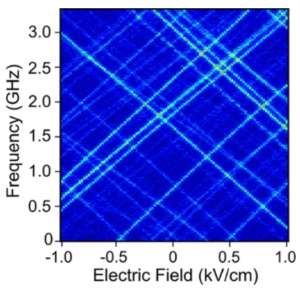Amin Moradi and Zoran Ristanovic are working on this project.
In a rigid molecular matrix at low temperature, a single fluorescent molecule can exhibit an intense and narrow absorption line, called zero-phonon line (ZPL). The spectral position of this line can be very narrow (10-50 MHz linewidth) and stable, or it can shift in the presence of electric field or local changes in its environment. Such sharp spectral features, highly sensitive to local environments and external electric fields, open many experiments in quantum optics, molecular spectroscopy, and nanoscale probing.
For our experiments, we typically embed fluorescent molecules such as terrylene and dibenzoterrylene (DBT) into molecular crystals of aromatic hydrocarbons, such as naphthalene and anthracene. We are also working on the development of new host-guest systems for high-resolution single-molecule spectroscopy. Our ongoing project is funded by the large EU initiative for quantum technologies (QUANTERA). In a multidisciplinary consortium of seven European research institutions (ORQUID), we are working on the integration of organic molecules into quantum devices that will interface photons, electrons and phonons. Our aim in this project is to detect single electrons optically, by means of the linear Stark effect (i.e., the shift of optical transition energy in electric field). Recently, our cryogenic team has demonstrated the first molecular crystal of DBT in 2,3-dibromonaphthalene that exhibits large and tunable linear Stark shift in the electric field (see Figure 1 below). This molecular probe will be used to optically detect individual quanta of charges in specially designed single-electron transistor devices based on Coulomb blockade.
You can read more about our recent work published in ChemPhysChem (link).

Figure 1. Large linear Stark effect of single DBT molecules embedded in a 2,3-dibromonaphthalene single crystal. The spectral lines of single DBT molecules (diagonal stripes) are strongly and linearly affected by the applied external electric field.


